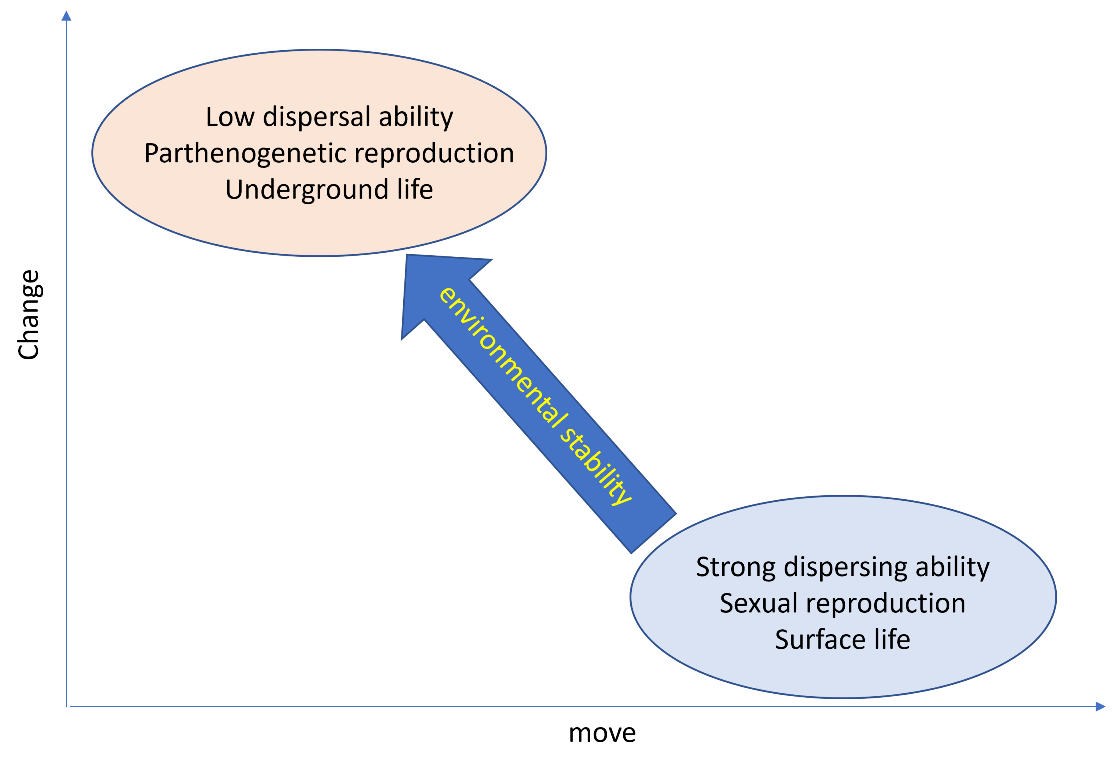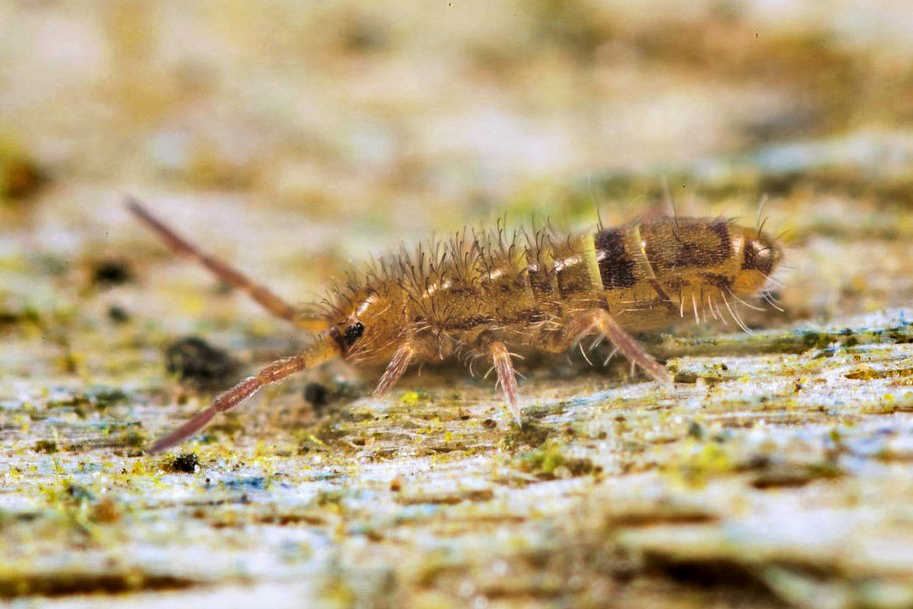Introduction :
In the article Evolution of springtails , I point out that springtails have managed to survive through geological eras, unlike other animal species that have suffered mass extinctions. These extinctions can be linked to biological changes in the environment such as episodes
of plant proliferation or resource depletion, as well as physical transformations of more or less extensive parts of the earth's surface, caused by volcanic eruptions. violent events, ejections of lava and ash, or even asteroid impacts.
It is therefore appropriate to ask how springtails managed to cope with such upheavals in their environment. Publications 1-2 on which I rely here have caught my attention by providing elements of an answer to this question.
Two options are considered:
- The ability of people to move geographically in search of more favorable conditions.
- The ability of populations to evolve to adapt to a hostile environment.
Conditions :
The transformations of the living conditions of the species within their original habitats, condemn them to necessary displacements or evolutions, morphological and/or physiological. Review the article Cryoprotective dehydration , in which I mention an example of adaptation of springtails to extreme conditions.
Climate change alters the environment in different ways, such as temperature variations in the waters and the atmosphere, significant fluctuations in the level of the oceans, phases of eutrophication, changes in the chemical composition of the atmosphere ( carbon dioxide, oxygen, methane, etc.), alterations in photosynthesis and glacial episodes, to name but a few.
It should be noted that even if these past evolutions and alterations took place over generally brief periods on the geological scale, their effects propagated at relatively slow rates, on a time scale ranging from a few hundred thousand years several million years. Consequently, they probably did little to hinder the Darwinian evolution of species.
Mass extinctions :
Contrary to the aforementioned “slow” evolutions, accidental events such as asteroid impacts could modify the environment in a more rapid way and, consequently, thwart the natural evolution of species. The intensity of these events depends on several factors taken into account in the Torino scale. The latter, which comprises ten levels, integrates the probabilities of collisions, sizes, masses and impact speeds of asteroids and makes it possible to establish a projection of their consequences. It should also be noted that the IMCCE (Institute of Celestial Mechanics and Ephemeris Calculation) lists these risks based on the asteroids identified to date.
Geological and paleontological studies indicate that on average, every millennium since the creation of the Earth, an asteroid 100 meters in diameter strikes our planet, causing the destruction of the equivalent of a large city or causing a tsunami with a 35 meter high wave flooding coastal areas. Every 100,000 years, an asteroid 500 meters in diameter destroys everything on an area comparable to that of France. Every 300,000 years, an asteroid about 1000 meters in diameter destroys the equivalent of a large country, resulting in an estimated loss of 100 million human lives. Finally, every 100 million years, a 10 km asteroid causes a planetary cataclysm by throwing dust into the atmosphere, creating a long winter, blocking photosynthesis and disrupting the food chain, resulting in a period of mass extinction.
However, not all mass extinctions3 are caused by such violent cataclysms. Only two of them are attributed to asteroid collisions. In the table below, the major known mass extinctions are listed. A red line indicates the appearance of the first fossilized traces of coprolites attributed to the ancestors of modern springtails.

Studies carried out on springtails reveal that these arthropods have colonized all the biotopes of the planet. However, when looking at springtail communities at the species level, there are significant differences between continents and islands due to their geographic isolation, as well as disparities at smaller geographic scales due to local adaptations. Finally, when we observe landscapes modified by human activity, we find that the most affected springtails are those whose movements are the slowest and the most limited in distance.
It is at this stage that displacement or adaptation offer two possible survival strategies for springtails. However, the answer to these proposed choices is not as straightforward as the terms "displacement" and "adaptation" would suggest. The researchers add nuance by noting that adaptation does not necessarily translate solely to genetics and that displacement is not the only means of avoidance.
The Displacement:
Springtails are organisms capable of moving to deal with various situations relating to their diet, their reproduction, their moults, the toxicity of their environment and the risks of desiccation. However, their ability to move varies depending on their habitat, either in the ground or on the surface. Olfactory communication through pheromones plays an important role in their journey over short distances in areas occupied by their own species (review chemical communication of springtails )
The morphological characteristics of springtails are closely related to their habitat. The hypogeal* species generally have shorter legs and antennae than those that evolve in the epigeal zone**. Species in the epigeal zone can move over longer distances by their own means, but their movements are limited to perimeters not exceeding 200 meters around their place of life, which is insufficient to preserve populations undergoing changes in temperature. their biotope on a regional or continental scale.
Beyond this distance threshold, the springtail must resort to other vectors. This is the case for phoresy, which is a mode of movement used by animals (known as phoretics) which allow themselves to be transported by other animals (hosts) over distances exceeding their own capacity for movement.
A study (2) carried out using insects imprisoned in fossil amber dating back 16 million years shows, in fact, that Collembola Symphypleones have used this mode of locomotion, by air (which does not exclude use of water/sea routes). This study analyzes two flying insects imprisoned in a piece of amber on which springtails have attached themselves.
The hosts, a winged termite and an ant, were allowed to be transported by air over long distances. Termites and ants which are social insects were abundant during the Miocene, since they represent more than a third of the insects trapped in ambers of this period. These winged insects were therefore most certainly major vectors.
Certain morphological characters have enabled springtails to cling to their hosts. The antennae appearing as the main means of fixation, due to a "tightening" organ available to certain species. The buccal apparatus has, to a lesser extent, also been used for phoretic attachment.
Researchers have identified other springtail migration strategies that are likely to be carried away by winds, by other larger animals moving with their feet, but also by being carried away by running water (rafting) or pushed by winds on the surface of the waters. A limit appears with regard to dispersion by air, which is not appropriate over long periods of time due to the sensitivity of springtails to desiccation.
Adaptation:
Adaptive changes are often highlighted by comparison of populations. DNA sequencing provides a better understanding of ongoing evolutionary processes, review “Study of the DNA barcode of springtails”.
Scientists have discovered that a Drosophila fly was able to adapt to heavy metal toxicity by duplicating the gene coding for a protein called "metallothienin". This protein has a high affinity for metal ions and contributes to the detoxification of contaminated organs and cells.
To date, no study has revealed a similar example in springtails, although genetic changes have been seen in Orchesella cincta exposed to metallic, bacterial or fungal stresses. However, it is difficult to draw clear conclusions from these observations. Researchers have also observed that in parthenogenetic populations of Mesaphorura macrochaeta subjected to stress, modes of sexual reproduction have reappeared, suggesting a more adapted selection of alleles***.
Folsomia candida, a parthenogenetic species known to be lucifuge and which moves over short distances in search of food, has a high phenotypic plasticity**** which allows it to resist drought, cold, pollution and high concentrations of CO². She can quickly colonize a new environment from a single female.
Non-adaptive changes can result from geographic isolations, as in the case of cave springtails or some species that live in Antarctica. In other families, chemical communication allows females to exercise a form of selection between spermatophores deposited by males. This can lead to avoidance behaviors and even lack of recognition, causing populations with specific genetic characteristics to split despite having the same origin.
Outside of hostile or unstable environments, springtails can adapt to periodic changes such as seasonality or slower changes in vegetation cover dynamics. Moving over short distances then makes it possible to maintain the populations in a favorable habitat.
It should also be noted that changes in agricultural practices such as plowing, irrigation, various treatments or crop modifications can suddenly modify the habitat of a population of springtails, which are then no longer adapted to their environment. .
In conclusion, the adaptation strategies of springtails result from several factors, as shown in the diagram below, proposed by the researchers.

Recent observations highlight a flexibility in the adaptive responses of species to environmental changes. Indeed, some species with high mobility can adapt to changes by avoiding movement, while other species with low dispersal ability can overcome distances greater than their ability to move through mechanisms that are still poorly understood.
 The researchers discovered that the "metallothionein" protein is overexpressed in Orchesella cincta (opposite left) . contaminated with heavy metals. Surprisingly, this springtail did not try to move to flee the contaminated areas...
The researchers discovered that the "metallothionein" protein is overexpressed in Orchesella cincta (opposite left) . contaminated with heavy metals. Surprisingly, this springtail did not try to move to flee the contaminated areas...
On the other hand, Folsomia candida and Mesaphorura (below), two species of springtails living below the ground surface, were the first to colonize surface mining areas, although their poor movement capacity would normally have prevented this colonization. The researchers then suggested that these springtails could have been transported on small pieces of earth attached to the legs or beaks of the birds.

These observations show that springtails have great phenotypic plasticity, allowing them to adapt to small-scale changes in their environment, such as natural or agricultural disturbances. They can also adapt vertically or survive as dormant eggs. However, it remains to be seen whether springtails will be able to cope with large-scale environmental changes, such as global warming. It is also important to ask whether the adaptive processes of springtails will reach their limits and lead to extinctions.
Conclusion :
In conclusion, research plays a crucial role in understanding the adaptive responses of arthropods to large-scale environmental changes. This knowledge could prove useful in the future for humanity, which seems to already have one foot in this new Anthropocene era where it will inevitably face the same dilemma faced by springtails today: "change or move".
Appendix :
* Species that evolve under the surface of the ground.
** Species that evolve on the surface of the soil.
*** Alleles are variants of the same gene.
**** Phenotypic plasticity is defined as the capacity for a cell or an individual, from a unique genetic sequence (called a genotype) present in its genome , to express one to several characteristics (called phenotypes) according to different contexts
Sources:
1 « Move or change, an eco-evolutionary dilemma: The case of Collembola » Jean-François Ponge Muséum National d’Histoire Naturelle, CNRS UMR 7179, 4 avenue du Petit Château, 91800, France. 7 February 2020 E-mail address: This email address is being protected from spambots. You need JavaScript enabled to view it.. Pedobiologia - Journal of Soil Ecology 79 (2020) 150625 0031-4056/ © 2020 Elsevier
2 Ninon Robin, Cyrille D’haese, Phillip Barden. Fossil amber reveals springtails’ longstanding dispersal by social insects. BMC Evolutionary Biology, 2019, 19 (1), ff10.1186/s12862-019-1529-6ff. ffhal02378619f
3 Université de Laval – Canada - http://www2.ggl.ulaval.ca/personnel/bourque/s4/extinctions.masse.html
Images: P.G. sauf :
Orchesella cincta © Jérôme Picard - https://www.flickr.com/photos/jeromepi/ - Site internet: https://www.aquanat-photo.fr/